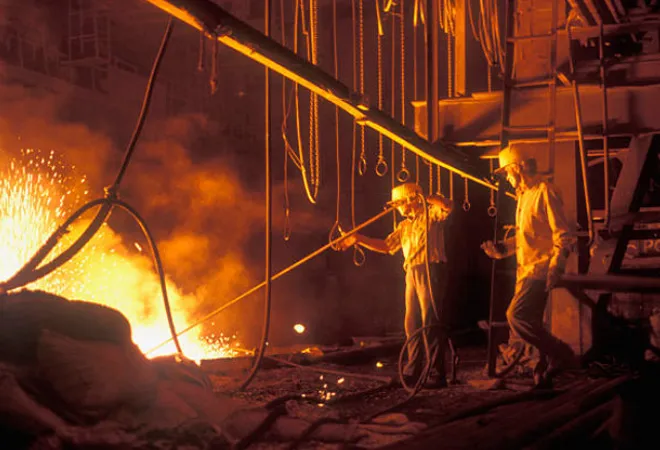-
CENTRES
Progammes & Centres
Location
India is concentrating more on connectivity projects to strengthen the India-Nepal relations and to cater to its security needs in the Northeast
 India’s most recent proactive infrastructural connectivity stance has been revolving around the ‘Mission Purvodaya’—an affiliate of the ‘Atmanirbhar Bharat’ programme. With the aim of transforming the country from a passive market to an active manufacturing hub, the programme has been curated to support a self-reliant India as a ‘Force Multiplier’ in the global economy. Consequentially, eastern India has been leveraged as the primary domain of focus and development that holds within itself the potential of taking India to newer heights of congruence and correspondence to greater multilateral platforms and deeper engagements with neighboring nations like as well. Even though the concept has begun with emphasis on the creation of an integrated steel hub encompassing the Indian states of Odisha, Jharkhand, West Bengal, and parts of Andhra Pradesh for the transformation of crude steel to value added steel, the mission is much beyond this framework in enabling holistic regional harmony in South Asia and beyond.
India’s most recent proactive infrastructural connectivity stance has been revolving around the ‘Mission Purvodaya’—an affiliate of the ‘Atmanirbhar Bharat’ programme. With the aim of transforming the country from a passive market to an active manufacturing hub, the programme has been curated to support a self-reliant India as a ‘Force Multiplier’ in the global economy. Consequentially, eastern India has been leveraged as the primary domain of focus and development that holds within itself the potential of taking India to newer heights of congruence and correspondence to greater multilateral platforms and deeper engagements with neighboring nations like as well. Even though the concept has begun with emphasis on the creation of an integrated steel hub encompassing the Indian states of Odisha, Jharkhand, West Bengal, and parts of Andhra Pradesh for the transformation of crude steel to value added steel, the mission is much beyond this framework in enabling holistic regional harmony in South Asia and beyond.
Indian strategic connoisseurs shifting focus to the east with frameworks like the Purvodaya is justified because of the luminary orientation of the space.Furthermore, within this larger platform, India has identified and held onto another space that has come to be of vitality—the North-eastern region, having the potential of leveraging greater connections to the country’s immediate neighbourhood. As a springboard of making a mark in the Bay of Bengal subregion, India has been proactive in identifying the pros of the Northeast as it covers 8 percent of the country’s geographical area and 5,300 kilometres of international border, thereby, favouring transnational connectivity. With better and modernised cross-border supply chains, up-to-date transportation, e-commerce integration and border infrastructure, all unrealised to its full potential till date, India has been putting in effort to capitalise on these already present resources at home. However, the region is also faced with operational challenges like small-scale insurgencies, migration, environmental stress, and crime-making sustainability of projects with transparency along with the participation of local partners in some major bottlenecks, leading India to tread on a relatively slower pace than expected. In this scenario, smaller countries like Nepal have been coming up time and again, demanding its importance as a major development partner for India, not only helping to combat the prevailing hiccups but also generating win in return through developmental assistance and its coveted desire to climb up the ladder of becoming a middle-income nation from being recently declared as a lower-middle income one. Some of the contemporary developments have been in the field of railways, roads, and integrated check posts between India and Nepal. The most recent buildout has been the Jaynagar-Kurtha cross-border rail connectivity (39.40 km) between India and Nepal, as a part of the Jaynagar-Bijalpur-Bardibas rail (68.72 km) project, that has been entirely funded by the Government of India, with around INR 550 crores. Jaynagar is only 4 kilometres from the India-Nepal border and the route also has Janakpur, a famous pilgrim destination for Nepal, thus also strengthening religious tourism network in the region. Taking cue from such completions, both the countries have also been engaging in joint working group meetings for further cross-border railway networks- the latest ones being the fifth Joint Working Group (JWG) and the seventh Project Steering Committee (PSC) meetings on 6-7 October 2021. A Memorandum of Understanding (MoU) was signed for the proposed broad-gauge railway between Raxaul and Kathmandu and the ongoing works of the Jogbani-Biratnagar broad gauge railway lines between India and Nepal, being developed with grant assistance from Government of India.
The six-lane major bridge of 675-metre-long and 15-metre vehicle underpass connects the Nepal-side border to India-side border and further to Kakarvitta in Nepal and the proposed Panitanki bypass of Asian Highway (AH 02) in India.Similarly, both the countries have been simultaneously working on the construction of the Mechi River Bridge and the resultant approach road, with the support of the Asian Development Bank (ADB) under the South Asia Sub Regional Economic Cooperation (SASEC) Road Connectivity Investment Program (“SASEC RCIP”). The six-lane major bridge of 675-metre-long and 15-metre vehicle underpass connects the Nepal-side border to India-side border and further to Kakarvitta in Nepal and the proposed Panitanki bypass of Asian Highway (AH 02) in India. The length of approach road in Nepal is 547 m. Through this around 500 kilometre of road will be expanded in North Bengal and the North-eastern Region (NB-NER) of India. Simultaneously, it will also help in upgrading and connecting the national highways of five countries—Bangladesh, Bhutan, India, Myanmar, and Nepal in the Northeastern part of India including North Bengal. At the same time, two governments have been concerned with the development of new integrated check posts. The newest one between India and Nepal has been proposed in November 2021 in Panitanki in the Darjeeling district of West Bengal, that is one of the liaison districts with the Northeast. This will be in addition to the ones already present in Raxaul-Birgunj, Jogbani-Biratnagar, Sunauli, and Rupaidiha, These ICPs will not only help in making cross-border transfers of people more lucid but would also process faster the passage of commercial vehicles, thereby, resulting in better trade and connectivity with the immediate neighbourhood.
China has been heavily investing in Nepal in several connectivity projects like the Trans Himalayan-Multi dimensional Connectivity Network.
The views expressed above belong to the author(s). ORF research and analyses now available on Telegram! Click here to access our curated content — blogs, longforms and interviews.

Sohini Nayak was a Junior Fellow at Observer Research Foundation. Presently she is working on Nepal-India and Bhutan-India bilateral relations along with sub regionalism and ...
Read More +